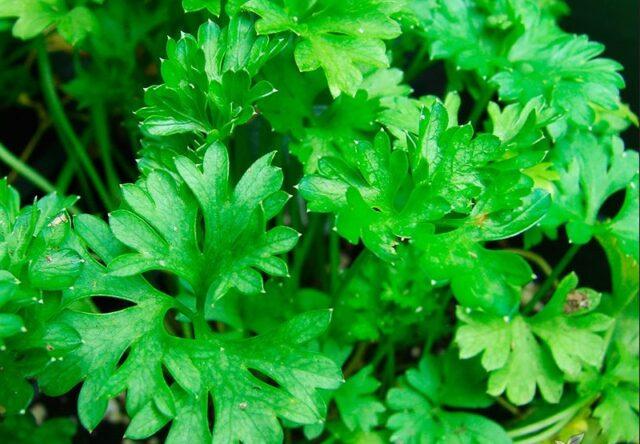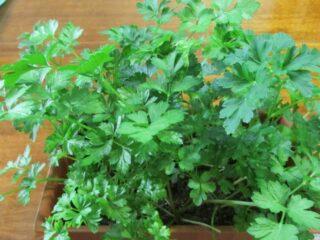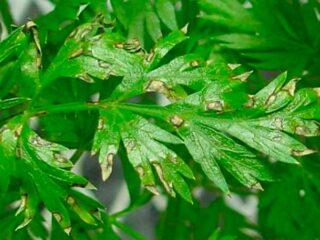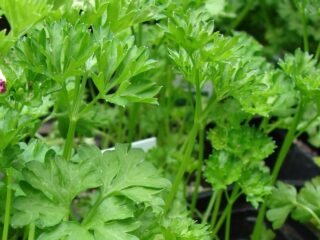Content
- 1 Pros and cons of growing parsley in seedlings
- 2 Which varieties are better to choose?
- 3 Timing for sowing parsley for seedlings
- 4 Planting parsley for seedlings
- 5 Parsley seedlings in a snail
- 6 Caring for parsley seedlings after germination
- 7 Possible problems during cultivation
- 8 Conclusion
- 9 Reviews on growing parsley seedlings
Parsley is one of the most common crops grown in garden plots. It is easy to care for, produces a good harvest, and has beneficial properties due to its chemical composition. Parsley seedlings are cultivated by many gardeners in order to obtain the spice as early as possible.

Depending on the timing of ripening, the spice can be early, mid-season and late.
Pros and cons of growing parsley in seedlings
The method of growing parsley from seedlings is suitable for leaf varieties, since root crops often produce lateral branches after transplantation and become gnarled. The advantages of the method include:
- Getting an early and abundant harvest.
- Creating comfortable conditions for young plants.
- Saving planting material.
- Possibility of growing heat-loving varieties in the northern regions.
- No need for thinning.
Among the disadvantages of the seedling method:
- Risk of damage to the root system during picking.
- The need to cover seedlings for the first time after planting in open ground.
Many gardeners prefer a combination of two options - to obtain part of the parsley using seedlings, and the rest by sowing directly into open ground.
Which varieties are better to choose?
To grow parsley seedlings, varieties that have shade tolerance, rapid growth, disease resistance and a pleasant taste are used. In addition to these characteristics, the size of the foliage and the height of the bush are of great importance.
Aster
Aster curly parsley (Etroselinum crispum Astra) is an early ripening variety. The productivity is high, the application is universal. The rosette is of medium height, slightly raised. The time from germination to harvesting is up to 60 days.

The yield of the Astra variety is up to 5 kg per square meter
Breeze
Parsley Breeze (Etroselinum crispum Briz) has a medium ripening period. Its rosette is high (up to 75 cm), erect. The greens are tender and slightly juicy. The growing season is 80 days. The yield of the variety is 2.5 kg per square meter.

Parsley Breeze is used in cooking and for processing
Carnival
Carnival parsley (Etroselinum crispum Karnaval) has a medium ripening period; the spice is used in salads. The rosette is of medium density and height. The period from germination to technical ripeness is three months.

Carnival parsley grows back well after cutting
Timing for sowing parsley for seedlings
They begin to sow the spice for seedlings in February. The exact date depends on the climatic conditions of the region.The time should be calculated so that after a month and a half the parsley can be planted in open ground. In the middle zone, sowing is carried out in the third ten days of February, in the Leningrad region - in early March, in Siberia and the Urals - in the second ten days.
According to the lunar calendar in 2023
To determine the most favorable time for sowing seedlings, you can use the lunar calendar. Planting garden plants on greenery is carried out in the phase of the waxing Moon. The most productive time is considered to be when the Earth's satellite is in such zodiac signs as Cancer, Scorpio, Pisces and Taurus. In 2023, the following days are favorable for sowing parsley seedlings:
- In February - 1-3, 21, 24, 25, 26, 28.
- In March – 1-3, 7, 16, 24, 25, 29-30.
- In April – 4-5, 13, 21, 22, 25-26.
Planting parsley for seedlings
Growing greens through seedlings allows you to get juicy spices already at the beginning of summer. To do this, you need to properly prepare the seeds, soil and containers. If agricultural practices are followed, after a month and a half, healthy grown parsley seedlings are transferred to open ground for growing.

At first, parsley seedlings develop very slowly
Soil selection and preparation
Loose, nutritious soil with neutral acidity (6.5-7.0 pH) is suitable for growing parsley seedlings. You can buy ready-made soil or make it yourself by mixing peat, garden soil, humus and sand in a ratio of 2:1:1:1.
Before use, the soil mixture is disinfected by calcination or steaming for one and a half hours. After this, it is spilled with a solution of Fitosporin.
Selection of capacity
The container for parsley seedlings should not be small.The crop has a powerful root system that goes deep into the soil, so the best option is a container with a wall height of 15-20 cm. Flower pots, containers, and 5-liter plastic bottles cut to the required height are quite suitable.
There should be drainage holes at the bottom to drain excess water. To prevent moisture from getting onto the windowsill, pallets are installed under the containers.
Seed preparation
Parsley seeds contain essential oils that prevent them from germinating prematurely. To speed up the process, you need to prepare the seeds accordingly:
- Soak in warm water for a day, changing it every four hours.
- Select those that have settled to the bottom.
- Treat the seeds with a growth stimulator (Epin).
- Dry.
- Place in a damp cloth and place in the refrigerator to “peck”.

Vernalization increases the rate and percentage of seed germination
Step-by-step instruction
After the preparatory work, they begin sowing parsley. To get healthy and strong seedlings in the shortest possible time, you should follow a certain scheme:
- Place a drainage layer of expanded clay 2 cm thick at the bottom of the pot or container.
- Fill the container with the prepared soil mixture.
- Make grooves 0.5 cm deep at 3 cm intervals.
- Moisten the soil with a spray bottle.
- Distribute the seeds at 2 cm intervals.
- Sprinkle them with soil with a layer of 0.5 cm.
- Spray generously with water.
- Cover the container on top with a lid, film, glass or non-woven material.
- Transfer the container to a warm place with an air temperature of +25 ⁰С.

The mini-greenhouse is ventilated daily and the soil is moistened as needed.
Parsley seedlings in a snail
Recently, the method of growing seedlings in a snail has become popular. It allows you to rationally use the space, avoid damaging the roots when picking seedlings, evenly illuminate all plants, and do not prepare a lot of soil.
The algorithm of actions is as follows:
- Cut a strip 10-15 cm wide from the substrate under the laminate (isolon or polypropylene foam).
- Lay it out on the table and spread the prepared soil over the surface in an even layer 1-2 cm high.
- Distribute the seeds by 2 cm from the top and 1.5 cm between them.
- Roll the tape tightly into a roll.
- Secure with an elastic band or tape.
- Place vertically in the tray.
- Pour water into it.
- Cover with film on top to create a microclimate.
- Open periodically for ventilation.
After the parsley sprouts, the snail along with the tray is transferred to a bright, cool place.

All turns in the resulting folded structure must be thoroughly watered
Caring for parsley seedlings after germination
You can get strong seedlings only through careful care and creating conditions for plant development.
Lighting
Seedlings need to be provided with a day length of about 12 hours. If there is a lack of natural light, you need to use artificial light from LED and phyto lamps, which are turned on in the evening and in cloudy weather. In April and May, parsley foliage should be protected from bright sun, creating shading. Otherwise, the seedlings get burned, turn yellow and dry out.
Temperature
The optimal temperature for the growth and development of parsley seedlings is +20 ⁰С. Heat-insulating material should be placed under containers and pots placed on a cold windowsill to prevent the roots from freezing and rotting. Seedlings must be reliably protected from drafts and at the same time ensure good ventilation.

Parsley needs a lot of light and heat to grow and develop.
Watering
Parsley loves water. To moisten the soil, use warm, settled liquid. Watering the seedlings is carried out as the soil dries, using a spray bottle, a syringe or a watering can with a long spout. Moisten the smallest plants with special care. After each procedure, the soil is carefully loosened.
Thinning and picking
After the emergence of seedlings, you need to pay attention to their density. One plant should have five square centimeters of area. To prevent seedlings from stretching out, the excess ones are removed or planted in separate containers. Parsley seedlings do not bend if the pots and containers are periodically turned on different sides to the sunlight.
Transplanting seedlings into open ground
As soon as stable warm weather arrives and the ground warms up, the strengthened parsley seedlings are planted in open ground. The soil is prepared in advance - in the fall, they dig deep, add organic matter, and add sand and sawdust to the clay soil. In early spring, it is loosened, ridges are formed, and covered with film to warm it up better.
Seedlings are placed in a permanent place late in the evening or in the morning in cloudy weather. Planted in rows, leaving a gap of 10 cm and 5 cm between plants.

Between the rows of parsley you can sow late cabbage for seedlings
The easiest way to plant parsley grown in peat cups or tablets.They are lowered into the prepared holes, lightly sprinkled with soil and watered. Seedlings in plastic containers need to be watered abundantly in advance, so that later you can remove the plant along with the earthen ball and plant it on the ridge without damaging the root system.
Possible problems during cultivation
The most common problem that arises when growing parsley seedlings is their stretching. The reason for this is insufficient lighting, short daylight hours and too high air temperatures. To correct the situation, it is necessary to install additional lighting and move the containers to a room with an air temperature of +16 ⁰С to +20 ⁰С.
Picking is an additional stress for parsley seedlings. To eliminate such situations, it is better to grow plants in separate pots and glasses, immediately providing a sufficient volume of soil for the root system and an area for the development of the above-ground part.
Conclusion
Parsley seedlings are grown by gardeners for the purpose of early production of greenery. The agricultural technology is simple, accessible to any beginner, and the effect is impressive - the spice can be obtained in sufficient quantities already at the beginning of June. The process is not labor-intensive; it is worth using in the practice of any gardener.
Reviews on growing parsley seedlings








